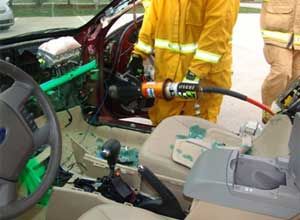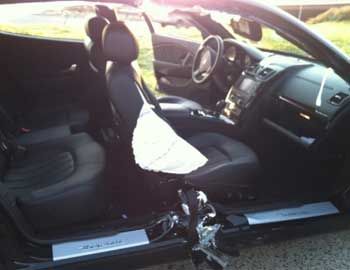Let’s look at the way we displace the side(s) of vehicles today. First off, be it a car, SUV or even a pick-up truck, most vehicles today have four doors (two on each side) more often than not.
When we “pop” doors today, the door materials often shred, tear and rip apart, leaving us to attack it another way or try to cut the door off.
Why does this happen? Well, think of doors of having “hard” points and “soft” points.
The lightweight door materials are coupled with high-strength latches and hinges by the door crash beam, and the whole ensemble is tied tighter together than before due to vehicle construction and design and its inherent ability to move crash energy throughout the vehicle structure.
So we know door “pops” have issues. But today’s cutters can make short work of cutting hinges and latches. Why not just cut them in the first place?
Cutting hinges and latches to remove the door creates much less stress and strain on the vehicle, which eases stress on the patient and the tool operator.
The evolution actually goes faster and smoother, making it safer. The key for this cutting technique is the ability to “visualize what you seek” (i.e. observe the hinge and/or the latch).
We must ensure the cutter blades get completely around the hinge or latch. We do not want to place the tips of the cutter on the hinge, which will make the tool “tip loaded” and cause damage to the blades.
 |
To do this, we must make space between the door and vehicle body so we can get the blades in and around the objects to be cut.
Watch tool reaction during this technique! Many times, we’re cutting square or rectangular material, which will cause the cutter to “swing” or torque quickly.
Also, ensure you have hard protection in place between the tool work and the patient and interior rescuer. As with roof post cuts, when you find wires in your path, cut them with a hand cutter like medic shears or battery cable cutters.
Why? Because many vehicles feature side-impact airbags in doors and side curtains in roof edges; these devices are impacted by static electricity as well as pressure and shock. When you’re using the cutters, static charges can back surge into the wiring.
As well as door displacements, side removals call for using cutters to make relief cuts into the B-post. These areas are usually well reinforced, so cuts can be difficult.
Displace trim at the base and top of the B-post to check for seat belt pretensioners, side curtain cylinders and the adjustable seat belt bracket.
 |
However, you will find that in taking both doors and the B-post as one unit — i.e. the total side removal goes faster — gives us almost the same amount of space as a roof removal and makes instant access to remove the patient from the vehicle.
It also sets us up for a rapid dash lift if we need to displace the dash to make additional space for disentanglement. The total side removal evolution has a quite a few names and can be done a few ways.
However, I am going to describe to you how to perform a B-post tear or a maxi-door evolution.
These areas are usually well reinforced, so cuts can be difficult. We need to displace trim at the base and top of the B-post to check for seat belt pretensioners as well as side curtain cylinders and the adjustable seat belt bracket.
There are a variety of ways to facilitate a side removal, but one of the most effective ways is to perform a B-post tear.
We start off with forcing the latch on the back door. Open the door fully; in fact, hyperextend the door forward a little. Then, taking the power hydraulic cutter make a relief cut into the base of the B-post, key point as deep and as straight as practical.
 |
Cut the top of the B-post as close to the roofline as possible. With the spreader, place one tip or arm above the relief cut on the base of the B-post and the other tip or arm against where the floor rises vertically to meet the rear seat.
Open the spreader. As the tool opens, the base of the B-post is pushed away from the vehicle’s rocker panel and the relief cut tears forward.
As it does, the weakest points are the spot welds on the base of the B-post; they pop and the base of the roof post comes away.
Sometimes the tear isn’t straight and might have bits of metal still connected. Take the cutter and cut them away. Then the entire side swings out on the front door hinges.
Once the entire side is out past 90 degrees, we can cut the hinges, displace the hinges with a spreader or push the entire side further back and tie it off.
 |
This will facilitate disentangling our patient quickly and safely. Remember though, rescuers, ALWAYS place hard protection between our tool work and the patient and interior rescuer.
ALWAYS cut wiring with a hand tool and not power hydraulics due to static concerns and ALWAYS cover up sharp edges, as this evolution will create a lot and in close proximity with our patient.
Try this evolution. I have found it goes faster than a normal door displacement in our work today, is much safer to both the patient and tool operator and creates almost the same amount of space as a roof displacement but on the same side as the patient, so we can have immediate access and disentanglement pathway for our patient.
As always — be safe out there, rescuers!
 |


